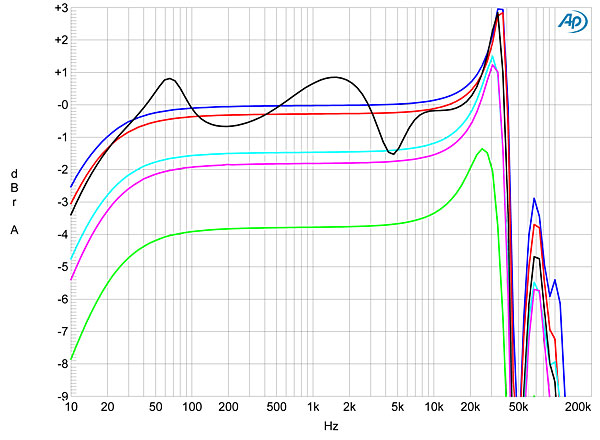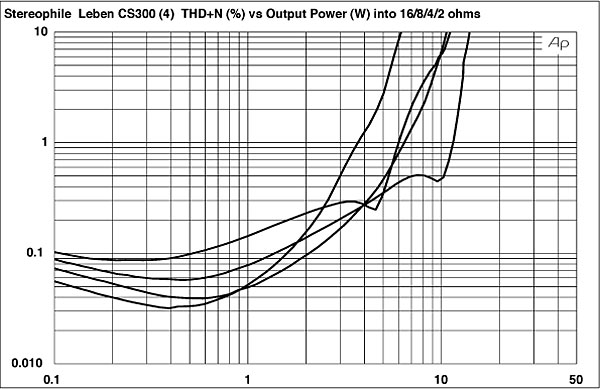| Columns Retired Columns & Blogs |
Nice!!
To measure the Leben, I used Stereophile's loaner Audio Precision SYS2722 system (see www.ap.com and the January 2008 "As We See It").
I assessed the Leben CS300 integrated amplifier's performance from its 4 and 8 ohm output transformer taps; unless specifically addressed, the behavior from the 6 ohm tap can be taken as being between those two extremes. The maximum voltage gain into 8 ohms was modest for an integrated amplifier, at 27.1dB (8 ohm tap), 27.3dB (6 ohm tap), and 27.6dB (4 ohm tap). All inputs preserved absolute polarity, and the input impedance was high, at 91k ohms at 20Hz, 60k ohms at 1kHz, and 51k ohms at 20kHz. The high impedance at 20Hz will be useful when the CS300 is used with the RS-30EQ.
The output impedance at 20Hz was similar from all three outputs at 3–3.5 ohms. It did differ at higher frequencies: at 1kHz, the impedance was 2.65 ohms (8 ohm tap), 2.25 ohms (6 ohm tap), and 1.8 ohms (4 ohm tap); at 20kHz, it was 2.4, 1.6, and 1.1 ohms, respectively. This impedance is sufficiently high to give rise to potentially audible ±1.1dB response variations with a typical loudspeaker, even from the 4 ohm tap (fig.1, gray trace). This graph also shows that the output transformer suffers from a major resonant peak at 34kHz, as well as a smaller one at 68kHz, both of which increase in amplitude with increasing load impedance. This gives rise to a significant amount of overshoot and ringing with a 1kHz squarewave (fig.2). The ultrasonic resonances are better behaved from the 8 ohm tap (fig.3), and there is less overshoot and ringing on a 1kHz squarewave (fig.4), though the 10kHz squarewave still has two cycles of ringing evident (fig.5).

Fig.1 Leben CS300, 4 ohm tap, frequency response at 2.83V into: simulated loudspeaker load (gray), 16 ohms (green), 8 ohms (blue), 4 ohms (magenta), 2 ohms (red). (0.25dB/vertical div.)

Fig.2 Leben CS300, 4 ohm tap, small-signal 1kHz squarewave into 8 ohms.

Fig.3 Leben CS300, 8 ohm tap, frequency response at 2.83V into: simulated loudspeaker load (gray), 16 ohms (green), 8 ohms (blue), 4 ohms (magenta), 2 ohms (red). (0.25dB/vertical div.)

Fig.4 Leben CS300, 8 ohm tap, small-signal 1kHz squarewave into 8 ohms.

Fig.5 Leben CS300, 8 ohm tap, small-signal 10kHz squarewave into 8 ohms.
Figs.1 and 2 were taken with the volume control set to its maximum. There is a 0.2dB imbalance between the two channels; this slight imbalance is maintained at lower settings of the volume control. Fig.6 shows the Leben's response with the Bass Boost set to 0, +3, and +5dB. Both boost settings end up with a similar-sized peak around 30Hz, but the +5dB setting results in significantly more upper-bass energy. The +3dB setting gives a boost of the right shape to compensate for a typical minimonitor's LF rolloff, but +5dB is just too much of a good thing and will also tax the amplifier's low-frequency linearity.

Fig.6 Leben CS300, 4 ohm tap, frequency response at 2.83V into 8 ohms with Bass Boost at 0, +3, and +5dB (left channel blue, right red; 1dB/vertical div.).
The CS300's channel separation (not shown) was good, at 74dB R–L and 82dB L–R at 1kHz, though this worsened to 50 and 58dB, respectively, at 20kHz. The unweighted, wideband S/N ratio, taken with the input shorted and the volume at its maximum, was good rather than great, at 71dB ref.2.83V from both channels with all three output taps. This was due to a regular series of low-level, power-supply–related spuriae at 60Hz and its even- and odd-order harmonics (fig.7). I experimented with the grounding between the CS300 and the Audio Precision SYS2700, but this behavior remained unchanged. The S/N ratio did improve to 83dB when A-weighted.

Fig.7 Leben CS300, 8 ohm tap, spectrum of 1kHz sinewave, DC–1kHz, at 1W into 8 ohms (linear frequency scale).
The Leben CS300 is specified as having a maximum power output of 12Wpc (10.8dBW). Figs.8 and 9 show how the THD+noise percentage varies with output power from the 8 and 4 ohm taps, respectively. Defining clipping as the power when the THD+N reaches 1%, these graphs show that the CS300 delivered its specified power at clipping when the output transformer was matched to the load. Less power is available into both higher and lower impedances, and the THD+N is respectably low below 2W or so when the load is equal to or higher than the nominal value of the transformer tap. Figs.10 and 11 show how the THD+N percentage varies with frequency at 2.83V (equivalent to 1W into 8 ohms) from the 8 and 4 ohm taps, respectively. The THD rises at low and high frequencies, as expected, and again, the CS300 is clearly unhappy when the load is below the nominal tap value.

Fig.8 Leben CS300, 8 ohm tap, distortion (%) vs 1kHz continuous output power into (from bottom to top at 1W): 16, 8, 4, 2 ohms.

Fig.9 Leben CS300, 4 ohm tap, distortion (%) vs 1kHz continuous output power into (from bottom to top at 1W): 16, 8, 4, 2 ohms.

Fig.10 Leben CS300, 8 ohm tap, THD+N (%) vs frequency at 2.83V into: 8 ohms (left channel blue, right red), 4 ohms (left green, right magenta), 2 ohms (gray).

Fig.11 Leben CS300, 4 ohm tap, THD+N (%) vs frequency at 2.83V into: 8 ohms (left channel blue, right red), 4 ohms (left green, right magenta), 2 ohms (gray).
Fortunately, the distortion in the midrange is almost entirely the subjectively innocuous third harmonic (fig.12), while at low frequencies, the second harmonic becomes predominant (fig.13), with higher-order harmonics all below –83dB (0.007%). However, the supply-related components at 60 and 180Hz lie at –78 and –72dB, respectively—these are either magnetically induced from the power transformer or stem from the tube heater supply. Provided that the load impedance was equal to or higher than the output transformer tap, the Leben CS300 did well on the high-frequency intermodulation test, with the difference component at 1kHz lying at –65dB left (fig.14, blue trace) and –59dB right (red trace).

Fig.12 Leben CS300, 4 ohm tap, 1kHz waveform at 2.5W into 8 ohms (top), 0.132% THD+N; distortion and noise waveform with fundamental notched out (bottom, not to scale).

Fig.13 Leben CS300, 8 ohm tap, spectrum of 50Hz sinewave, DC–1kHz, at 1W into 8 ohms (left channel blue, right red; linear frequency scale).

Fig.14 Leben CS300, 8 ohm tap, HF intermodulation spectrum, DC–24kHz, 19+20kHz at 3W peak into 8 ohms (left channel blue, right red; linear frequency scale).
The Leben CS300 measures as well as can be expected from its retro design and use of a pair of EL84 tubes for its output stage. The only thing that bothered me was the output transformer's ultrasonic resonances, which become more fully developed into higher impedances. Paradoxically, it is into those higher impedances that the CS300 is at its most linear. I am less impressed by the RS-30EQ phono preamplifier, mainly because of its very high output impedance.—John Atkinson